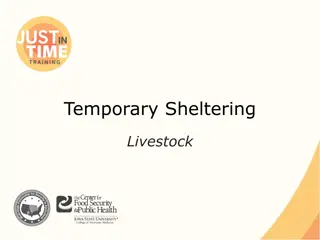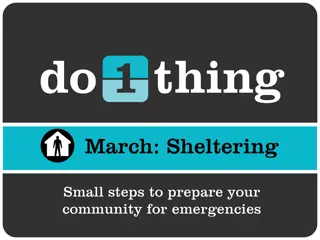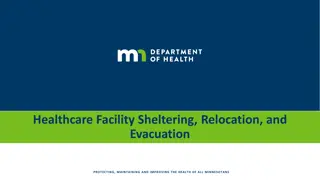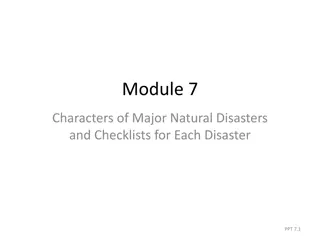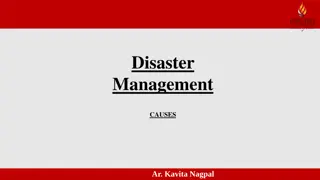Temporary Sheltering for Companion Animals During Natural Disasters
Ensure the safety of pets during natural disasters by setting up temporary shelter facilities with proper assessment, planning, and supplies. Locations out of the affected area, facilities with water source and sanitation, and necessary supplies for animals are essential for managing companion animals in emergencies.
Download Presentation

Please find below an Image/Link to download the presentation.
The content on the website is provided AS IS for your information and personal use only. It may not be sold, licensed, or shared on other websites without obtaining consent from the author. Download presentation by click this link. If you encounter any issues during the download, it is possible that the publisher has removed the file from their server.
E N D
Presentation Transcript
Temporary Sheltering Companion Animals
Natural Disasters People evacuating with their pets Evacuation facilities do not allow pets Pet owners may refuse to evacuate Pets left behind Injured, displaced or lost pets Dogs, cats, pocket pets, birds Temporary Sheltering: Companion Animals Just In Time Training
SETTING UP A SHELTER Temporary Sheltering: Companion Animals Just In Time Training
Assessment and Planning Location and facilities Animal requirements Supplies and housing Sanitation Security Volunteer training and coordination Temporary Sheltering: Companion Animals Just In Time Training
Location Out of affected area Near human shelters Possible locations Animal control or humane society shelters Veterinary hospitals Pet boarding facilities Dog training centers Fairgrounds, school gyms, parking garage, warehouses Temporary Sheltering: Companion Animals Just In Time Training
Facilities Water source Adequate size Ventilation and climate control Sanitation and waste disposal Allow for animal segregation Species, age, illness, aggression Temporary Sheltering: Companion Animals Just In Time Training
Supplies Animal supplies Food and water Kennels and crates Collars, leashes Bowls Cat litter Medical supplies Cleaning supplies Office Supplies Temporary Sheltering: Companion Animals Just In Time Training
Sanitation Prevent spread of disease Keep environment clean Procedures for Waste removal and disposal Cleaning and disinfection Shovels or scoopers, buckets and mops, hoses, scrub brushes, trash cans, sawdust Detergent, broad spectrum disinfectants, paper towels, disposable gloves Separate equipment should be used for isolated animals Temporary Sheltering: Companion Animals Just In Time Training
Site Security Needed to limit unauthorized access Protect animals on-site Prevent pillage of stored supplies Controlled substances Locked cabinets Authorized veterinary personnel Methods Shelter is well lit, especially in evening Control entry and exit points Log book of persons entering/exiting shelter Locked doors at nighttime Personnel present at all times of day Temporary Sheltering: Companion Animals Just In Time Training
Volunteers Animal handling experience Pre-exposure rabies vaccination desirable Register all volunteers Training and coordination Incident Command System critical Animal handling Personal protection and appropriate PPE Infection control procedures Temporary Sheltering: Companion Animals Just In Time Training
ANIMAL ARRIVAL Temporary Sheltering: Companion Animals Just In Time Training
Animal Identification Identification number and collar Record sheet Animal description Owner s name, cell Location found Date found Photograph Book of photos for owners to find pets Temporary Sheltering: Companion Animals Just In Time Training
Incoming Assessment Physical exam Veterinarian Microchip scan Triage Sick and injured animals Potential procedures Bathing Parasite treatment Vaccination Temporary Sheltering: Companion Animals Just In Time Training
Animal Handling Stressed and fearful Proper handling minimizes stress Decrease risk through training Report all animal bites and scratches Highly aggressive animals should only be handled by experienced personnel Temporary Sheltering: Companion Animals Just In Time Training
Animal Housing Every pet needs a cage Plastic, collapsible, wire Large enough for Food dishes Standing Lying down Litter box for cats Appropriate density Temporary Sheltering: Companion Animals Just In Time Training
Sanitation Processing areas, high traffic areas Between each animal Entire area once a day Feces Removed daily from runs and cages Removed immediately from play areas Broad spectrum disinfection Use according to product label New solutions daily or when visibly dirty Clean and disinfect equipment after use Separate equipment for isolation animals Temporary Sheltering: Companion Animals Just In Time Training
Animal Management Daily Food and water Clean bowls and cages Dogs walked Visual health checks As needed Medical treatment Bathing Record sheet Temporary Sheltering: Companion Animals Just In Time Training
Infection Control Infectious disease Cleaning and disinfection Isolation area Clear posting on cage Limit contact Protective clothing Visual health checks before handling Temporary Sheltering: Companion Animals Just In Time Training
Resources American Veterinary Medical Association. Emergency: Preparedness and Response Guide https://ebusiness.avma.org/EBusiness50/files/productdo wnloads/emerg_prep_resp_guide.pdf AVMA and CDC. Interim Guidelines for Animal Health and Control of Disease Transmission in Pet Shelters https://www.llis.dhs.gov/member/secure/detail.cfm?con tent_id=19712 U.S. Department of Homeland Security Lessons Learned Information Sharing: Shelter Operations Pet-Friendly Shelters http://www.lsart.org/sites/site- 1707/documents/ShelterOperations- PetFriendlyShelters2.pdf Temporary Sheltering: Companion Animals Just In Time Training
Resources (contd) LSU Emergency Animal Shelter Disaster Response Manual http://www.lsuemergencyanimalshelter.org/ Louisiana State Animal Response Team Companion Animal Evacuation and Sheltering Manual www.lsart.org/refId,12776/refDownload.pml ASPCA (American Society for the Prevention of Cruelty to Animals) Sample Plans for Evacuation and Sheltering http://www.aspcapro.org/sample-plans-for-evacuation- and-shelteri.php Temporary Sheltering: Companion Animals Just In Time Training
Acknowledgments Development of this presentation was by the Center for Food Security and Public Health at Iowa State University through funding from the Multi-State Partnership for Security in Agriculture Authors: Sarah Weiland; Katie Steneroden, DVM, MPH, PhD, DACVPM Reviewer: Glenda Dvorak, DVM, MPH, DACVPM


